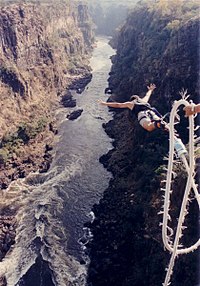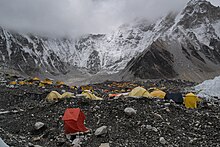Extreme tourism, also often referred to as danger tourism or shock tourism (although these concepts do not appear strictly similar) is a niche in the tourism industry involving travel to dangerous places (mountains, jungles, deserts, caves, canyons, etc.) or participation in dangerous events. Extreme tourism overlaps with extreme sport. The two share the main attraction, "adrenaline rush" caused by an element of risk,[1] and differ mostly in the degree of engagement and professionalism.


Well-known extreme tourist destinations include:
- Chernobyl tours – Ukraine[2][3]
- Swimming in the Devil's Pool in Victoria Falls – Zambia and Zimbabwe[4][5]
- Hiking the Chang Kong Cliff Road on Mount Hua – China[4][5]
- Yungas Road tours – Bolivia[4]
- Green Zone – Baghdad, Iraq[6]
- Sac Actun tours – Riviera Maya, Mexico[4]
- Cave of Swallows – Mexico[4]
- Pole of Cold – Oymyakon, Yakutia, Siberia[citation needed]
- Wreck of the Titanic – Atlantic Ocean[7]
- Mount Everest – Nepal
- North Korea
- Yemen
- Afghanistan
- Space tourism[7]
See also
editReferences
edit- ^ "Extreme Tourism". Deutsche Welle (Video). May 7, 2021. Archived from the original on May 16, 2021. Alt URL
- ^ Johnson, George (October 2014). "The Nuclear Tourist". National Geographic. Vol. 226, no. 4. pp. 122–139. ISSN 0027-9358. Archived from the original on April 13, 2021.
- ^ Brooks, Rosa (June 26, 2005). "Globetrotting Ghouls With Digital Cameras". The Los Angeles Times. p. 23 – via Newspapers.com.
- ^ a b c d e Binns, Melissa (July 13, 2019). "Extreme Tourism: 10 Of The Most Dangerous Places In The World Only The Brave Dare Visit". TheTravel. Valnet.
- ^ a b Avakian, Talia (September 21, 2015). "16 adrenaline junkie attractions to visit in your lifetime". Business Insider.
- ^ "Wish you were here? Pensioner clocks up 'extreme tourism' visits to Iraq, Afghanistan ad other trouble spots". The Daily Telegraph. March 26, 2009 – via Newspapers.com.
- ^ a b Smith-Schoenwalder, Cecelia (June 29, 2023). "Despite 'Titan' Submersible's Fatal Wreck, Extreme Tourism Among the Ultra Wealthy Isn't Going Away". U.S. News & World Report. pp. C8–C11.